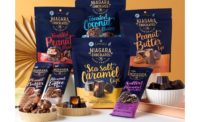Breaking the mold: How Beyond Good is reinventing the chocolate business
Beyond Good looks to expand its model of chocolate production at origin from Madagascar to East Africa.


















Building a chocolate factory has been part of Tim McCollum’s plan since he founded Beyond Good, formerly Madécasse, in 2008.
On its own that’s not an easy feat, but the location for the company’s first state-of-the-art production facility added another layer of difficulty. Beyond Good set up shop in Madagascar, where it sources rare, wonderfully fruity Criollo cacao directly from farmers.
Though Africa — West Africa, in particular — supplies 70 percent of the world’s cocoa, the “statistical equivalent of 0 percent” of the world’s chocolate is produced there, McCollum says. There are several reasons for that, ranging from a lack of infrastructure, the need to ship and install manufacturing equipment, employee training, and ultimately, the distribution of profits.
“They all add up to it being a very difficult proposition,” McCollum says. “But creating serious value requires doing things that haven’t been done before. We have zero interest in the status quo. Sub-zero.”
Breaking from the norm, and especially the traditional chocolate supply chain, is at the core of Beyond Good’s mission. McCollum, who formed his connection to Madagascar during a two-year stint as a Peace Corps volunteer there, got an outsider’s look at the chocolate industry and the areas in which it needed help.
The most pressing issues the cocoa supply chain faces — farmer poverty, transparency in sourcing, and by extension, child labor, deforestation and climate change — can’t be addressed with a top-down approach, McCollum realized.
“The solutions they come up with in most cases don’t work for the people at the very beginning or the bottom of the supply chain, who are the cocoa farmers. Our perspective was the complete opposite,” he says.
Though the global COVID-19 pandemic has slowed progress for now, Beyond Good, armed with a new name that’s more reflective of its objective, plans to expand its production-at-origin model outside Madagascar and into continental East Africa.
Farmers and the factory
Over the years, Beyond Good has partnered with contract manufacturers in Madagascar and in Italy to produce its chocolate bars, but McCollum says the ultimate goal is to produce as much as possible in Madagascar, boosting the value of the export.
Not that Madagascar’s heirloom cocoa isn’t already special. The island nation is one of just 10 countries to export 100 percent Fine and Flavour Cocoa, according to the International Cocoa Organization. Fruity and not bitter, it has notes of strawberry, raspberry and cranberry.
After seven years, Beyond Good hit a production ceiling with its co-manufacturer in Madagascar, prompting work on a new factory in Antananarivo, Madagascar’s capital, to begin in 2016. Construction wrapped up in late 2018 and early 2019.
Last year, the facility produced half of Beyond Good’s total output — the Italian co-manufacturer produced the other half — but McCollum expects 75 percent of its chocolate products to be made in Madagascar this year.
The factory currently employs 42 people, many of whom had never had an indoor job or tasted chocolate before. That’s created quite a learning curve, McCollum says, but producing chocolate in Madagascar links farmers and employees to the entire process.
Beyond Good routinely brings its farming partners — two cooperatives, one medium-holder farmer and one large individual farming operation based in northwest Madagascar — into the manufacturing facility to taste the chocolate and see roasting, grinding and other production stages. It illustrates why their growing, drying and fermenting practices are so critical to making a quality product.
“That gets them infinitely more engaged in the farming work, but you can only do that if you manufacture at origin,” McCollum says. “They’re brought full circle into the entire supply chain they’ve been cut out of for a long time.”
Sourcing cocoa and manufacturing under one umbrella allows the farmers to earn more — five to six times more, McCollum says — since there aren’t other intermediaries seeking to divvy up the profits across the supply chain. This model also offers total transparency from pod to wrapper, eliminating the need for programs to combat poverty, child labor, deforestation and other issues.
“If a farmer makes a decent income, and there is a direct, commercial relationship between the farmer and the person making chocolate, all the other issues in the industry melt away.” McCollum says.
Moving forward
Beyond Good plans to expand beyond Madagascar, which is part of the reason why it changed its brand name from Madécasse at the end of last year. Madécasse also wasn’t the easiest name to remember or pronounce — something the company learned early on its history.
“That had been holding us back for a long time,” McCollum says. “We’d always known we wanted to change it, but it took us awhile to get to the point where we were comfortable with such a big decision.”
Now’s the time, since Beyond Good plans to bring its chocolate production-at-origin model to Uganda, an East African country that produces 30,000 tons of cocoa each year. The company also has access to a proprietary supply chain there through its relationship with its co-manufacturer.
McCollum expects it’ll take two years to get a factory operational, but the COVID-19 pandemic has suspended progress. In the meantime, Beyond Good has introduced three new chocolate bars featuring Ugandan cocoa and is researching from afar the area in which it hopes to work.
McCollum says Tanzania is also on the company’s radar, since its cocoa is closer in flavor to Madagascar’s. But no matter what shape it takes or where it happens, moving forward is a must, not only for Beyond Good, but for the chocolate industry as a whole.
“It would be silly if we just wanted to keep it as a small business in Madagascar,” McCollum says. “The real test of the model is can we replicate it.”
Looking for a reprint of this article?
From high-res PDFs to custom plaques, order your copy today!















